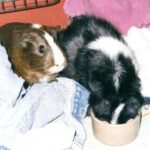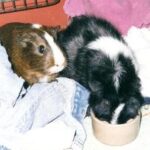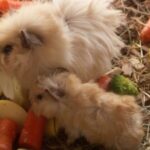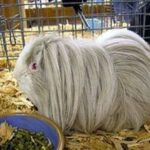Guinea pigs or cavies clean themselves often. A guinea pig that stops grooming itself is a sick guinea pig. Keep your guinea pigs healthy by keeping their cages as clean as possible. How is this done? By changing the bedding as often as possible, by washing the cage in a pet-safe solution once a week and by checking the guinea pig’s water bottle for leaks.
Safe Bedding
Not all bedding sold at pet stores or online that claims it is safe for guinea pigs is actually safe for guinea pigs. Guinea pigs are browsers and taste everything, including their bedding material. When choosing bedding, keep in mind that at some point the guinea pig will eat it.
Like people, guinea pigs can develop allergies to certain substances like the phenols in cedar or pinewood oil. Cedar shavings and pine shavings that have not been kiln-dried are unacceptable bedding materials. Kitty litter is also unacceptable bedding as a guinea pig can die from eating it. Corn cob is unacceptable because it grows dangerous molds when wet, according to Guinea Lynx.com.
Safe bedding choices include:
- Aspen wood shavings
- Recycled paper bedding for pets
- Hay – although this is an expensive alternative and should only be used mixed with other beddings
- Old clothes or towels in an emergency or short-term use only because they get soiled so quickly
Spot Cleaning
Wet bedding not only stinks but soon grows bacteria and mold that can get a guinea pig ill. Be sure to check that water bottles do not leak. If they do leak, they need to be changed. If the guinea pig likes to play with the water bottle and splashes water about rather than drinks it, then spot cleaning every day is a must. Just scoop out the wet spots under the water bottle and replace with fresh bedding.
Also be sure to remove any fresh fruits or vegetables within 24 hours of offering them to the guinea pig. Remove sooner if the treats begin to smell. Decaying fresh food can also introduce dangerous bacteria into a guinea pig environment.
The Big Clean
The guinea pig needs to be placed in a play pen or another safe place while the cage is being cleaned. All the water bottles and food dishes need to be cleaned. Use a bottle brush to remove the entire gunk that collects at the bottom of the bottle. Discard any urinated on toys or chew sticks. Dump all of the old bedding into the garbage or compost heap. Use the back of a dustpan or a clean paint scraper to pry off any hardened clumps.
Wash the cage itself in a solution made from 50 percent white vinegar and 50 percent water. Never use strong-scented cleaners like Lysol or Pinesol because they contain chemicals called phenolics. Phenolics are poisonous to guinea pigs, according to Sharon L. Vanderlip, DVM.
Rinse the cage top and bottom with hot water and dry with a clean towel. Fill with clean dry bedding, replace the food dish and water bottles and place the guinea pig back in the nice clean cage.
Summary
How do you keep nice, clean cages for your guinea pigs? With time, effort, hot water, white vinegar and a safe place to keep the guinea pig while the cages are being cleaned. Sanitation should be an everyday concern for guinea pig owners.
Sources
Vanderlip, DVM, Sharon L. The Guinea Pig Handbook. Barron’s; 2003.
Bedwell-Wilson, Wendy. “There’s No Place Like Home.” Guinea Pigs. Bow Tie Press; 2005.
Guinea Lynx.info. “Bedding.” http://www.guinealynx.info/bedding.html
Author’s personal experience







